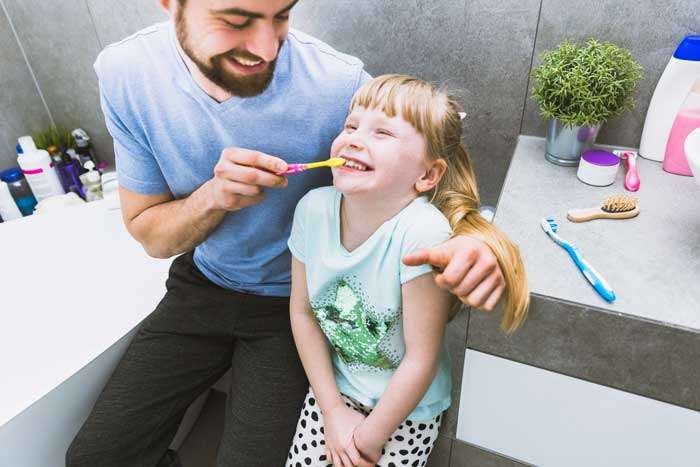

- Booking+91 9207 26 88 77
- Talk to Us+91 9633 08 88 00
Maintaining an oral hygiene routine for children can be quite challenging for parents and caregivers. Many parents often express concerns about their children not brushing their teeth adequately or neglecting to do so. This can cause risks not only to their dental health but also to their overall health. Learn more about our pediatric dental services.
One way to tackle this herculean task is by incorporating their favorite music or songs into the brushing session. Another approach is to involve them in role-playing scenarios. Children often enjoy pretending to be grown-ups, so let them play dentist for their favorite dolls or stuffed animals. Not only does this make brushing more entertaining, but it also helps to reinforce the importance of dental care in a playful manner.
Incorporating storytelling into the brushing routine adds an element of excitement to the daily routine and makes the experience more enjoyable. You can create fun narratives about the adventures their teeth go on every time they brush, turning it into a playful storytelling session. The narratives could involve scenarios such as fighting off worms residing in their mouth or building a tooth fairy kingdom within their mouth, strengthening their teeth with each brush stroke. Discover the importance of storytelling in child development.

Before diving into the tooth-brushing session, ensure that children are in a comfortable and accessible position. One option is to have the child sit or stand at a height where the caregiver can easily reach them and have full access to their mouth. Another effective technique is the knee-to-knee posture when two caregivers are present. For children who are hesitant to brush, a teether can be positioned on one side to prevent biting while brushing the other side, and vice versa. Parents or caregivers should not be discouraged by children’s resistance by crying during brushing sessions, instead continue with the process. Prioritizing and preventing the formation of cavities is more important, considering the potential consequences of pain, infections, and swelling that children may experience later.
Ensuring proper brushing technique and toothpaste usage is essential. Using a finger toothbrush (for less than 3 years) or soft-bristled kids toothbrush, caregivers should brush their child’s teeth twice a day, two minutes each time. For children aged 1 to 3 years, it is recommended to use a smear or grain-sized amount of toothpaste. For children older than 3 years, a pea-sized amount of fluoride toothpaste is recommended.
Brushing should be done gently but thoroughly, covering the front, back, and chewing surfaces of the teeth. Chewing surfaces of teeth have pits and grooves where food debris can become trapped. These areas require thorough attention to prevent the formation of cavities. When guiding children in brushing their teeth, it is important to emphasize the technique of using small, circular strokes. This method is comparatively easier and it ensures thorough cleaning while being gentle on their teeth and gums.
It is recommended to replace toothbrushes approximately every 3 months. As toothbrush bristles wear off with regular usage, they become less effective at removing plaque and food particles from the teeth.

Tongue cleaning as part of the daily oral hygiene routine maintains fresh breath and overall oral health by eliminating the bacteria, food remnants, and dead cells accumulated on the tongue.
Incorporating the habit of flossing as soon as two teeth come into contact is essential for promoting good oral hygiene. When two teeth are touching, it creates a space where food particles and plaque can become trapped. These trapped particles can lead to the formation of cavities between the teeth and cause irritation of the gums, gradually developing gum diseases. Flossing helps in cleaning the tooth surfaces that toothbrushes cannot reach. When introducing flossing to children, use age-appropriate flossing tools such as floss picks that make it easier for them. Caregivers should demonstrate proper flossing techniques and supervise children until they can floss independently.
In addition to all the above techniques, children should adopt the simple habit of rinsing their mouth after every meal, which can significantly improve dental health. In the case of breastfeeding, it is preferable to gently wipe the gums, teeth, and inner cheek with a damp cotton or gauze afterward.
One of the most effective ways to encourage children to develop good oral hygiene is by serving as role models. Children often learn best by imitation, so when they see their parents or caregivers prioritizing dental hygiene, they are more likely to follow them.
It is necessary to reward them with small gifts when there is improvement in their brushing habit. This creates a positive impact and encourages them to prioritize their dental health even more.
Establishing a daily oral hygiene routine along with scheduling regular dental check-ups with their Pediatric dentist(once in 6 months) can ensure your child a lifetime of good oral health. Start early and let them smile confidently. Book your child’s next dental check-up here.
Latest Blogs
Guide to Oral Hygiene for Kids: Daily Dental Care Routine...
Choosing the Right Toothbrush And Toothpaste – A Specialist Insight...
OUR BRANCHES